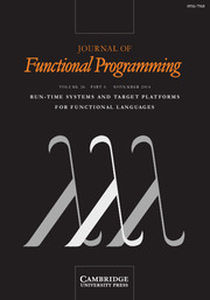Article contents
Using transformations in the implementation of higher-order functions
Published online by Cambridge University Press: 07 November 2008
Abstract
Traditional functional languages do not have an explicit distinction between binding times. It arises implicitly, however, as one typically instantiates a higher-order function with the arguments that are known, whereas the unknown arguments remain to be taken as parameters. The distinction between ‘known’ and ‘unknown’ is closely related to the distinction between binding times like ‘compile-time’ and ‘run-time’. This leads to the use of a combination of polymorphic type inference and binding time analysis for obtaining the required information about which arguments are known.
Following the current trend in the implementation of functional languages we then transform the run-time level of the program (not the compile-time level) into categorical combinators. At this stage we have a natural distinction between two kinds of program transformations: partial evaluation, which involves the compile-time level of our notation, and algebraic transformations (i.e., the application of algebraic laws), which involves the run-time level of our notation.
By reinterpreting the combinators in suitable ways we obtain specifications of abstract interpretations (or data flow analyses). In particular, the use of combinators makes it possible to use a general framework for specifying both forward and backward analyses. The results of these analyses will be used to enable program transformations that are not applicable under all circumstances.
Finally, the combinators can also be reinterpreted to specify code generation for various (abstract) machines. To improve the efficiency of the code generated, one may apply abstract interpretations to collect extra information for guiding the code generation. Peephole optimizations may be used to improve the code at the lowest level.
Information
- Type
- Articles
- Information
- Copyright
- Copyright © Cambridge University Press 1991
References
- 4
- Cited by


Discussions
No Discussions have been published for this article.